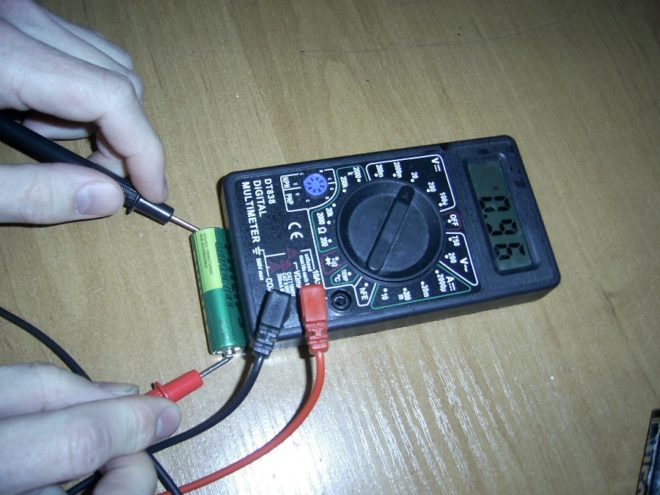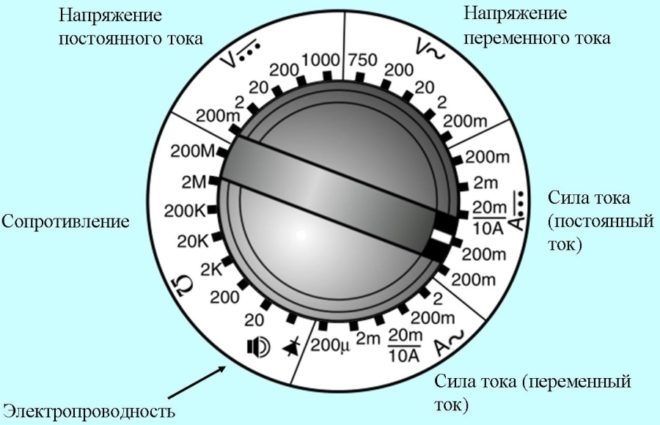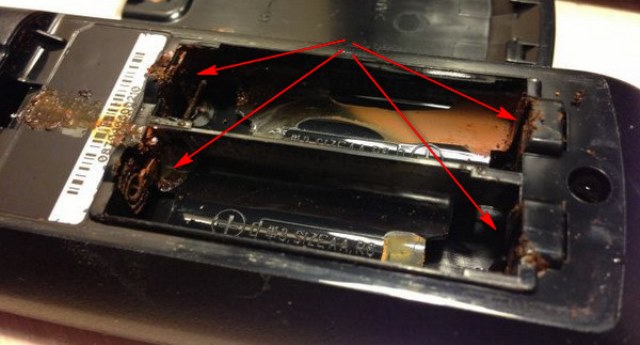How to measure the battery charge with a multimeter

Finger-type batteries are used in many modern devices as batteries. Although outwardly these products are indistinguishable from each other, their technical parameters, as well as cost, can vary significantly. In order not to get into a mess by purchasing a product with a small resource, or even completely inoperative, you should know how to check these elements, and be able to do it in practice. This skill will come in handy when checking the batteries accumulated at home - if one of them is in a landfill, then others can still serve in devices that do not differ in power. In this article we will figure out how to check the battery with a multimeter, and at what amount of residual charge it can be used in electrical appliances.
Content
No load charge test
To identify completely faulty elements, it is enough to make a simple check:
- Select the multimeter mode corresponding to DC voltage measurement.
- Set the measurement limit equal to 20V.
- Apply the test leads of the device to the contacts of the tested battery and measure the voltage.
- Take readings of the tester.

If the voltage shown when checking the battery with a multimeter is more than 1.35V, the battery is good and will work in any electrical appliance. If the cell charge is less than this level, but not lower than 1.2V, it can be used in undemanding devices. At a lower charge level, the battery cannot be used and must be disposed of.
For completeness, such a check is not enough, since it shows the magnitude of the no-load voltage (EMF).
As a load element, you can use an ordinary light bulb designed for use in a pocket flashlight. LEDs are not suitable for this due to too little resistance. The load volume should be between 100 and 200 mA - this is the most common figure for most modern medium power electrical products.
However, to reject clearly unusable batteries, a no-load test with a tester is sufficient. If the device shows less than 1.2V, checking under load is meaningless.

Testing electrical batteries with a multimeter under load
The remaining elements are retested. Now let's figure out how to check the battery capacity under load. To do this, proceed as follows:
- Connect the test leads of the multimeter to the contacts of the battery under test.
- Connect the load element in parallel and wait 30-40 seconds.
- Remove the obtained result.
Depending on the readings of the device, the measured elements must be sorted. Batteries with 1.1V or less remainder can be safely disposed of. Products, when checking which the device showed up to 1.3V, can be used in remote controls. If the element under load shows 1.35V or more, it is fully functional.
Testing batteries by measuring current strength
This method is applied to new batteries and allows you to evaluate their power immediately upon purchase. The position of the multimeter must correspond to DC current. To measure the amount of charge on a new battery, proceed as follows:
- Set the battery tester to the maximum measurement limit.
- Take a new element and attach the test leads of the device to its contacts.
- After 1-2 seconds, after the growth of the current value on the indicator stops, the probes must be removed.

The normal current for a new battery should be 4-6 Amps.If it is 3-3.9 Amperes, this means that the battery's service life is reduced, but the cell is suitable for use in portable equipment.
Multimeter readings in the range of 1.3-2.9 Amperes indicate that it is better not to use a battery in ordinary household appliances, but it can be installed in devices that consume a small amount of current (for example, television or other remote controls).
If the value of the current shown by the tester is 0.7-1.1 Amperes, then such an element is capable of working exclusively in devices with low power consumption, while the quality of the equipment will decrease. It can be used in remote control systems, but only if there are no better elements at hand.
Visually, the process of checking batteries with a multimeter in the video:
Useful Tips
Here are some guidelines for battery use and disposal:
- Do not delay checking and sorting accumulated batteries at home. In the absence of new batteries or insufficient quantity of them, you can temporarily use the tested one if necessary.
- Batteries that have sat down in a household appliance do not need to be completely replaced. Usually, their discharge does not occur simultaneously, and the check will reveal the batteries that can be used further.
- Do not store unusable batteries at home and, moreover, do not keep them in the equipment case. Often, electrolyte leaks out of them, and this leads to damage to nearby things.

- Do not try to damage the battery case in any way - the liquid (acid or alkali) in it can get on the skin, causing a chemical burn.
In addition, used batteries should not be thrown into trash cans. The electrolyte contained in them is harmful to the environment, therefore the batteries must be disposed of in a place that is specially designed for this purpose.
Conclusion
In this material, we figured out how to correctly check the battery with a multimeter, as well as in which devices the tested batteries can be used, based on the measurement results. As you can see, in order to measure the remaining battery charge, it is enough to have a home tester on hand and have a few minutes of free time.




